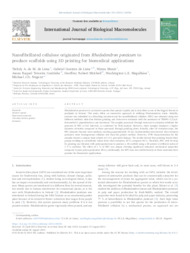Nanofibrillated cellulose originated from Rhododendron ponticum to produce scaffolds using 3D printing for biomedical applications.
Nanofibrillated cellulose originated from Rhododendron ponticum to produce scaffolds using 3D printing for biomedical applications.
Author(s): LIMA, T. A. de M. de; LIMA, G. G. de; MUNIR, N.; COUTINHO, J. R. T.; MITCHELL, G. R.; MAGALHAES, W. L. E.; NUGENT, M. J.
Summary: Rhododendron ponticum is an invasive species that spreads rapidly and is described as one of the biggest threats to peatlands in Ireland. This study offers an innovative approach to utilizing Rhododendron waste. Initially, sawdust was submitted to a bleaching treatment and the nanofibrillated cellulose (NFC) was obtained using two different methods: ultra-fine friction grinding and twin-screw extrusion with the assistance of TEMPO (2,2,6,6- tetramethyl-1-piperidinyloxy) pre-treatment. The samples processed through twin-screw extrusion exhibited the presence of NFC at five intervals, as confirmed by TEM analysis. However, these samples displayed a higher diameter deviation compared to those processed through grinding alone. Notably, after 20 extrusion steps, the NFC diameter became more uniform, reaching approximately 35 nm. Sedimentation tests showed that extrusion produced more homogeneous cellulose size than the grinder method. However, FTIR characterization for the samples showed a unique band related to C-O-C glycosidic linkage. The results showed that grinding breaks these groups resulting in crystallinity values lower than extrusion, 50 % compared 60 %. Therefore, NFC with 20 steps by grinding was blended with polycaprolactone to produce a 3D scaffold using a 3D printer at different ratios of 1–5 % addition. The effect of 1 % of NFC was unique showing significant enhanced mechanical properties compared to pure polycaprolactone (PCL), additionally, the NFC does not exhibit toxicity so these materials show promise for biomedical applications.
Publication year: 2023
Types of publication: Journal article
Unit: Embrapa Forestry
Observation
Some of Embrapa's publications are published as ePub files. To read them, use or download one of the following free software options to your computer or mobile device. Android: Google Play Books; IOS: iBooks; Windows and Linux: Calibre.
Access other publications
Access the Agricultural Research Database (BDPA) to consult Embrapa's full library collection and records.
Visit Embrapa Bookstore to purchase books and other publications sold by Embrapa.

